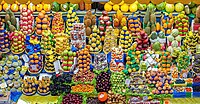
Photo from wikipedia
In blood banking, storage at 4°C for weeks is known to cause damages to erythrocytes, called storage lesions that may later cause transfusion-related adverse events. In previous experiments, we found… Click to show full abstract
In blood banking, storage at 4°C for weeks is known to cause damages to erythrocytes, called storage lesions that may later cause transfusion-related adverse events. In previous experiments, we found that vegetable/fruit juices can effectively reduce the storage lesion. Currently, we attempt to analyze the potential bioactive components and test whether the compounds can improve the storage lesions of erythrocytes. Equal portions in wet weight of 20 fresh vegetables and fruits were blended with phosphate buffered solution (PBS), and clear solutions were produced as additive to the packed erythrocytes from consented blood donors at 1 : 10 ratio (ml : gram). The blood samples were stored for 35 days at 4°C, and the supernatants were performed high liquid chromatography–mass spectrometry (HPLC-MS) analysis at 0 days, 14 days, and 35 days. The blood bags supplemented with identified bioactive components were stored in a refrigerator for 35 days, and the morphology, complete blood count (CBC), phosphatidylserine (PS) extroversion, hemolysis, and reactive oxygen species (ROS) levels were measured at the end of storage. Five potential bioactive components from vegetable/fruit juices contributed to the improvements of storage lesion. One of the compounds was unequivocally identified as naringin, and two were tentatively assigned as vitexin 6″-O-malonyl 2″-O-xyloside and luteolin 7-(6″-malonyl neohesperidoside). Naringin alleviated the storage lesion of red blood cells (RBCs) by reducing ROS levels and living cell extraction with HPLC-MS is a simple, reliable, and effective method for screening potential bioactive components.
Journal Title: Journal of Analytical Methods in Chemistry
Year Published: 2022
Link to full text (if available)
Share on Social Media: Sign Up to like & get
recommendations!